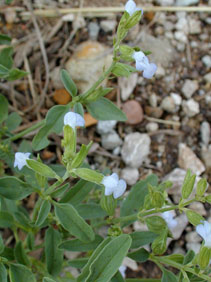LANCE-LEAF SAGE
|
 |
| File Size: 71 KB |
|
|
|
Salvia reflexa Hornem.
|
| Konza Prairie, Riley County, Kansas |
| Annual |
| Height: 4-28 inches |
| Family: Lamiaceae - Mint Family |
| Flowering Period: June, July, August, September,October |
|
| Also Called: | | Rocky mountain sage. | | Stems: | | Erect or ascending, branched above base, minutely pubescent to glabrous. | | Leaves: | | Opposite, lanceolate to narrowly elliptic, up to 2 inches long, less than 1/2 inch wide, usually glabrous above, pubescent or glabrous below; margins entire to slightly toothed; tips blunt or rounded; stalks 1/5 to 4/5 inch long. | | Inflorescences: | | Spike-like, interrupted, 2-6-flowered clusters; bracts lanceolate, less than 1/4 inch long, much shorter than calyx. | | Flowers: | | Flowers mostly opposite, 1 per axil; calyx bell-shaped, 1/4 to 1/3 inch long, 2-lipped; corolla 2-lipped, 1/4 to 1/3 inch long, dark to pale blue or whitish, minutely pubescent outside, glabrous inside; upper lip cap-like; lower lip turned downward; corolla tube protruding only slightly from the calyx; stamens 2. | | Fruits: | | Nutlets, egg-shaped, about 1/10 inch long, smooth, tan, mottled with dark brown. | | Habitat: | | Disturbed areas, pastures, roadside ditches, and prairie washes; dry, sandy or gravelly soils. | | Distribution: | | Throughout Kansas. | | Toxicity: | | Toxic to cattle, sheep and goats due to its accumulation of nitrates. This can also occur when it is fed in hay. However, this is rarely a problem because animals must consume large amounts of the plant and it occurs infrequently. | | Comments: | | Lance-leaf sage is very aromatic. |
|
| Lance-leaf sage calyces |  | | 63 KB | | Konza Prairie, Riley County, Kansas |
| | Lance-leaf sage leaves |  | | 68 KB | | Konza Prairie, Riley County, Kansas |
| | Lance-leaf sage corollas |  | | 59 KB | | Konza Prairie, Riley County, Kansas |
| | Lance-leaf sage post-flowering |  | | 140 KB | | Konza Prairie, Riley County, Kansas |
| |
|
|
|
|
|
|